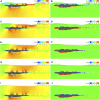Analysis of fluid force and flow fields during gliding in swimming using smoothed particle hydrodynamics method
- PMID: 38846802
- PMCID: PMC11153747
- DOI: 10.3389/fbioe.2024.1355617
Analysis of fluid force and flow fields during gliding in swimming using smoothed particle hydrodynamics method
Abstract
Gliding is a crucial phase in swimming, yet the understanding of fluid force and flow fields during gliding remains incomplete. This study analyzes gliding through Computational Fluid Dynamics simulations. Specifically, a numerical model based on the Smoothed Particle Hydrodynamics (SPH) method for flow-object interactions is established. Fluid motion is governed by continuity, Navier-Stokes, state, and displacement equations. Modified dynamic boundary particles are used to implement solid boundaries, and steady and uniform flows are generated with inflow and outflow conditions. The reliability of the SPH model is validated by replicating a documented laboratory experiment on a circular cylinder advancing steadily beneath a free surface. Reasonable agreement is observed between the numerical and experimental drag force and lift force. After the validation, the SPH model is employed to analyze the passive drag, vertical force, and pitching moment acting on a streamlined gliding 2D swimmer model as well as the surrounding velocity and vorticity fields, spanning gliding velocities from 1 m/s to 2.5 m/s, submergence depths from 0.2 m to 1 m, and attack angles from -10° to 10°. The results indicate that with the increasing gliding velocity, passive drag and pitching moment increase whereas vertical force decreases. The wake flow and free surface demonstrate signs of instability. Conversely, as the submergence depth increases, there is a decrease in passive drag and pitching moment, accompanied by an increase in vertical force. The undulation of the free surface and its interference in flow fields diminish. With the increase in the attack angle, passive drag and vertical force decrease whereas pitching moment increases, along with the alteration in wake direction and the increasing complexity of the free surface. These outcomes offer valuable insights into gliding dynamics, furnishing swimmers with a scientific basis for selecting appropriate submergence depth and attack angle.
Keywords: flow field; fluid force; gliding; numerical analysis; smoothed particle hydrodynamics (SPH); swimming.
Copyright © 2024 Liu, Yu, Meng, Hao, Chen and He.
Conflict of interest statement
The authors declare that the research was conducted in the absence of any commercial or financial relationships that could be construed as a potential conflict of interest.
Figures











Similar articles
-
Hydrodynamic analysis of human swimming based on VOF method.Comput Methods Biomech Biomed Engin. 2017 May;20(6):645-652. doi: 10.1080/10255842.2017.1284822. Epub 2017 Jan 27. Comput Methods Biomech Biomed Engin. 2017. PMID: 28127994
-
The Effect of Depth on Drag During the Streamlined Glide: A Three-Dimensional CFD Analysis.J Hum Kinet. 2012 Jun;33:55-62. doi: 10.2478/v10078-012-0044-2. Epub 2012 Jul 4. J Hum Kinet. 2012. PMID: 23487502 Free PMC article.
-
How do swimmers control their front crawl swimming velocity? Current knowledge and gaps from hydrodynamic perspectives.Sports Biomech. 2023 Dec;22(12):1552-1571. doi: 10.1080/14763141.2021.1959946. Epub 2021 Aug 23. Sports Biomech. 2023. PMID: 34423742 Review.
-
SPH modelling of depth-limited turbulent open channel flows over rough boundaries.Int J Numer Methods Fluids. 2017 Jan 10;83(1):3-27. doi: 10.1002/fld.4248. Epub 2016 May 25. Int J Numer Methods Fluids. 2017. PMID: 28066121 Free PMC article.
-
Techniques and considerations for monitoring swimmers' passive drag.J Sports Sci. 2019 May;37(10):1168-1180. doi: 10.1080/02640414.2018.1547099. Epub 2018 Nov 19. J Sports Sci. 2019. PMID: 30449240 Review.
References
-
- Ala G., Francomano E., Tortorici A., Toscano E., Viola F. (2006). Smoothed Particle ElectroMagnetics: a mesh-free solver for transients. J. Comput. Appl. Math. 191, 194–205. 10.1016/j.cam.2005.06.036 - DOI
-
- Antuono M., Colagrossi A., Marrone S. (2012). Numerical diffusive terms in weakly-compressible SPH schemes. Comput. Phys. Commun. 183, 2570–2580. 10.1016/j.cpc.2012.07.006 - DOI
-
- Arellano R., Pardillo S., Gavilán A. (2002). “Underwater undulatory swimming: kinematic characteristics, vortex generation and application during the start, turn and swimming strokes,” in Proceedings of the 20th international symposium on Biomechanics in sports. Editor Gianikellis K. E. (Spain: Caceras; ).
LinkOut - more resources
Full Text Sources

